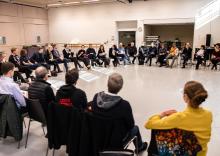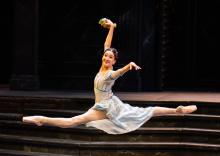
Successful third edition of the work conference Positioning Ballet
From 24 until 26 February, artistic directors from leading ballet companies all over the world came together in Amsterdam for the third edition of the work conference Positioning Ballet, organised by Dutch National Ballet. For many of them, it was the first opportunity in a long while to see their fellow directors again in person and to expand their network through new encounters.
The artistic directors talked to each other about current social developments that influence the work of ballet companies, and discussed the future of the art of ballet. Despite the differences between the companies and the environment in which they present their work, there turned out to be many similar and overarching challenges. Various ways of tackling these challenges were shared.
Opening
The work conference opened on Friday 24 February with questions from the think tank – comprising international ballet students – of Assemblée Internationale, a collaboration between ballet academies. One of these questions was: how can you ensure that dancers of colour feel welcome and comfortable in a ballet company? The artistic directors were asked by the think tank, who attended via video link, to continue to learn together and remain open to the many changes in the world. Hendrikje Crebolder, one of the directors of the Rijksmuseum, then outlined in an interview how a more diverse composition of the museum’s own team and a broader dialogue with the public and other interested parties have contributed to stronger links between the Rijksmuseum and society.
Discussion topics
During the second and third day of the conference, there was further extensive discussion on several topics related to the future of ballet, within the theme ‘Transitioning Times’. Moderator Peggy Olislaegers, Associate on research & development with Dutch National Ballet, and advisor to various choreographers and art institutions in Europe, shared the questions and issues underlying these topics that had been collected earlier from the participants.
Examples of relevant questions the directors put to each other were: How do you take a choreographer or visiting rehearsal director into the company’s work culture and company goals without denying their autonomy?; How do you develop a culture in which this conversation becomes an organic part of the creative process?; What do you do when their behaviours do not align with company guidelines and values, no matter how famous they are?
How is the physical, mental and artistic training and support of the dancers evolving?; Do you, as a company, have everything they need?;
Is a one-leader artistic leadership, with the many and growing different responsibilities an artistic director traditionally fulfills still realistic?; Which alternative and new models are possible?
Communication and organisation topics
The third and final day of the conference was introduced by consultant Christina Barandun, who presented the directors with various communication and organisation models for shaping developments in their professional field along with their organisation.
Important questions included: How can you ensure that talks actually result in change and growth?; What dialogue is necessary and with whom?; How can you make this dialogue part of the system?
Conclusion
The conference concluded with the agreement that the directors will continue the dialogue over the coming period, through Zoom meetings, for example. Ted Brandsen, director of Dutch National Ballet and curator of the conference, and Assis Carreiro, co-curator of the conference with Peggy Olislaegers, will think about a follow-up.



